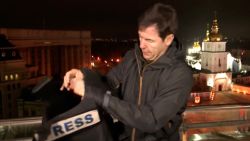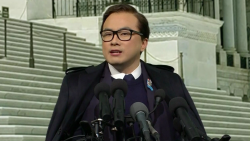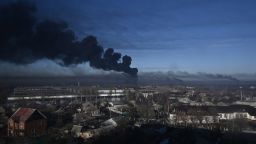The bombs in the Ukrainian capital went off as CNN was broadcasting live on-air.
“There are big explosions taking place in Kyiv right now,” Matthew Chance, a senior international correspondent for the network, said as he broadcast from a rooftop shortly after Russian President Vladimir Putin announced the Russian invasion of Ukraine.
Chance had been speaking to anchor Don Lemon when the missiles unexpectedly landed in the distance. The CNN correspondent heard the thunderous sound of the beginnings of war at the same time viewers at home did.
Over the next 12 hours, Chance offered viewers what they have come to expect from the cable news channel during times of conflict and war: a raw, on-the-ground view of the shifting scene around him.
Chance left his initial rooftop location and took viewers to a wooded area where Ukrainian forces were taking defensive positions. Then he visited an airfield taken over by the Russians.
Throughout it all, audiences at home were able to watch Chance try to make sense of the rapidly developing situation with him in real-time.
“Frankly, we didn’t even know the Russian forces were going to be here,” Chance said from the airfield from which he was broadcasting. “We came to speak with them … but it only emerged during the conversation that they’re all Russians and there are no Ukrainian military forces in sight – although I can hear them because they’ve been shooting ferociously.”
It was a stunning moment to see playing out on live television – and Chance was only one of several CNN journalists broadcasting live from the region as all hell broke loose. The network had correspondents and anchors fanned out across the region, broadcasting from multiple cities and on both sides of the Ukrainian-Russian border.
The coverage contrasted CNN with other television networks that had slimmer resources in the region and were more often seen discussing the perilous situation with guests from studios in the US.
In fact, the television coverage on display from CNN harkened back to images seen on the network during the Gulf War and Iraq War, when CNN bested its competitors and offered an exclusive window into the scenes playing out on the ground. But this time, the action was eerily unfolding in Europe, invoking comparisons to the two world wars which arose from that continent.
Each of the other networks did, of course, bring their viewers special coverage with correspondents in Russia and Ukraine.
And, at times, the danger to crews broadcasting from standup locations inside hotels was also apparent.
NBC News correspondent Erin McLaughlin broadcast live on MSNBC as she took shelter in the parking garage of her Kyiv hotel when an air siren started wailing in the city.
“We were in our hotel and we heard the siren go off,” McLaughlin said on “Morning Joe.”
On CBS News, correspondent Charlie D’Agata said he could hear fighter jets overhead as he broadcast from a balcony in Kyiv. And on ABC News, Ian Pannell also described seeing an aerial fight, reporting that his crew had “seen and heard more attacks,” including “two fighter jets fighting low.”
Over on Fox, correspondent Steve Harrigan described “black smoke coming up” from an explosion behind him, “probably a missile.”


























